The International Olympic Committee has officially announced that Brisbane will host the 2032 Olympic and Paralympic games. We now have an opportunity of a lifetime to give South East Queensland an injection of sustainable transport infrastructure that will last us a lifetime.
According to the Australian Bureau of Statistics, the current population of the South East Queensland urban area is 3.8 million. Over the next 20 years, an additional 2 million people are expected to call SEQ home, bringing our total population to around 5.8 million people.
If we continue to put mass transit second and roads first, we will end up with a Sydney-style infrastructure catch up situation.
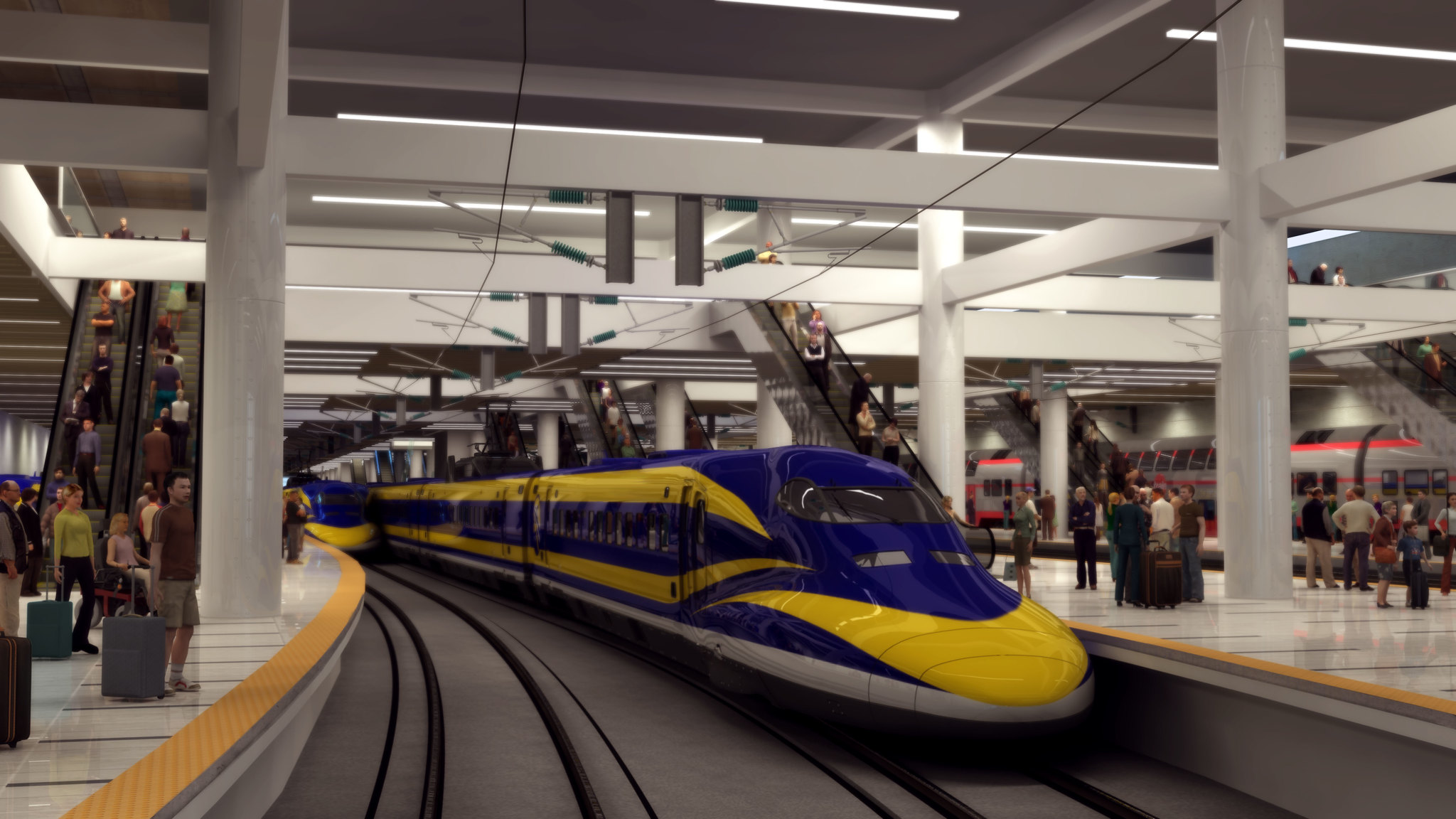
High speed rail or fast rail would fundamentally change the dynamic of the entire region. People could realistically live on the Gold Coast and commute into Brisbane or vice versa at a fraction of the time it use to take to travel.
Instantly, upon opening of the line, our region would become one large accessible metropolitan area unlike anything in Australia, but actually fairly common throughout some Asian and European metro areas. The system would also work for rural Queensland, opening up new affordable transit communities whilst giving existing ones new leases on life.
We are a lifestyle region as much as a growing business and industry hub, we cannot keep saying we don’t have the population, finances or political will for rail infrastructure that would benefit millions, because we do. Queensland is a very rich state which has always looked forward, but we need to be smart with how we spend these Olympic infrastructure dollars that we are about to receive.
Why build sustainable infrastructure?
Queenslanders shouldn’t see the Olympics as two weeks of sport, we should see it as a way to pave future prosperity through sustainable infrastructure.
Unfortunately, upgrading road infrastructure connecting large population centres like Brisbane and the Gold and Sunshine Coasts creates induced demand, which basically means you are creating a favourable environment for cars and therefore additional traffic will join the road.

Eventually, no matter how many lanes you put on a highway, it will end up where we started, gridlocked. Good examples of this can be seen all over American cities which continually expand freeways every ten years and don’t invest in mass transit. Arterial roads are vital for freight and the trades, so it is important that we reduce congestion which also costs the economy billions each year.
The alternative is very clear and is used throughout Europe and Asia. High speed rail and fast rail not only moves large amounts of people around quickly, but also long distances are no longer a problem. More train services can be added to scale up capacity and this helps to save space on existing roads for essential services.
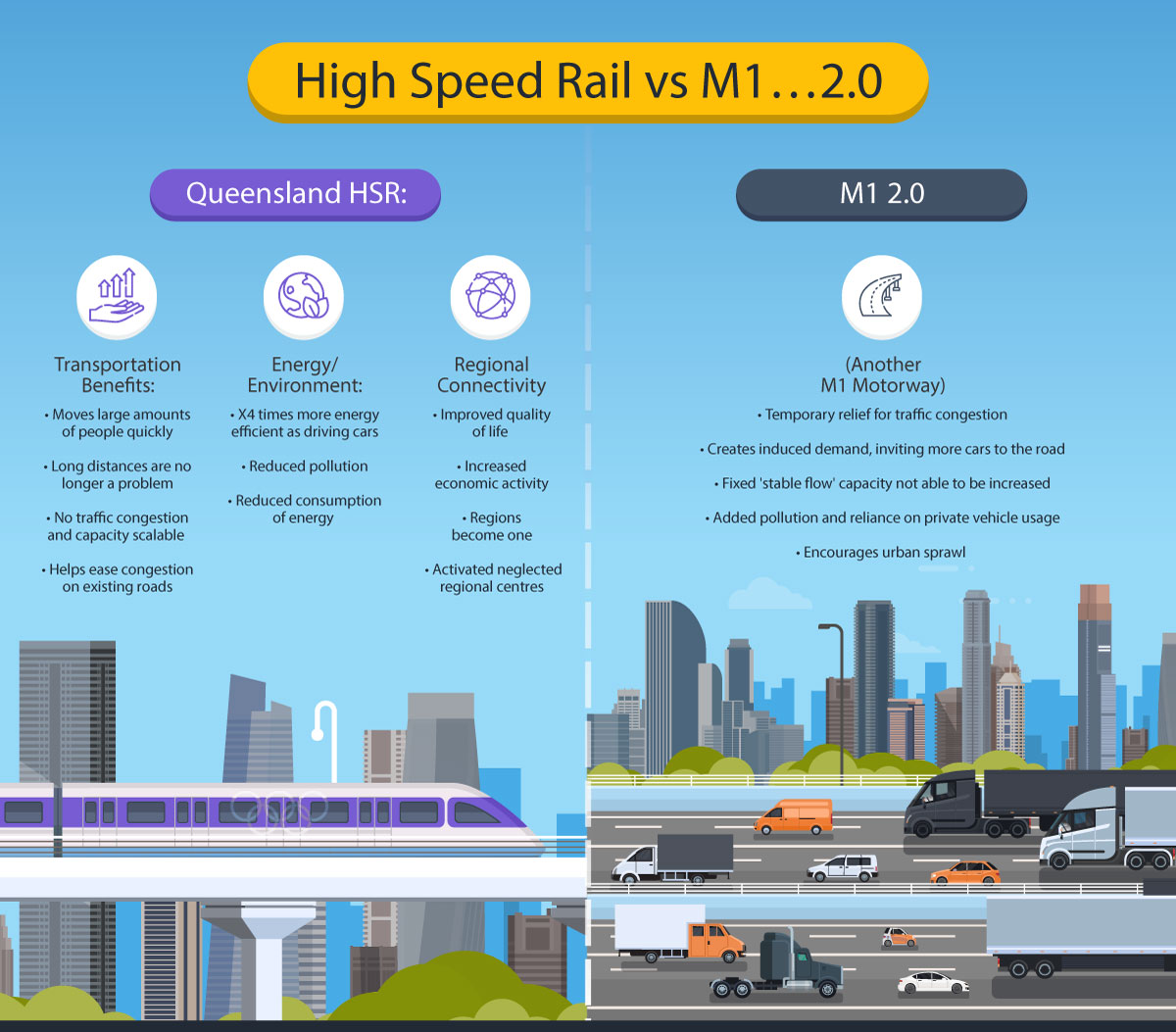
Commencing later this year, the 45-kilometre Coomera Connector freeway project is set to be built between Loganholme and Nerang, effectively half duplicating the M1 motorway between Brisbane and the Gold Coast. This project has a cost of $1.53 billion and is being jointly funded 50:50 by the State and Federal Governments.
Undoubtedly, this will help fast growing communities specifically around Coomera, Pimpama and Ormeau. These are regions that are destined to accomodate a vast amount of Queenslanders into the future. Investment in our inter-city, regional rail system however, is lagging behind where it should be. These communities ultimately only have one choice at the moment, and that is to drive and it will only get worse without a fast rail solution.
Possible Route & Funding
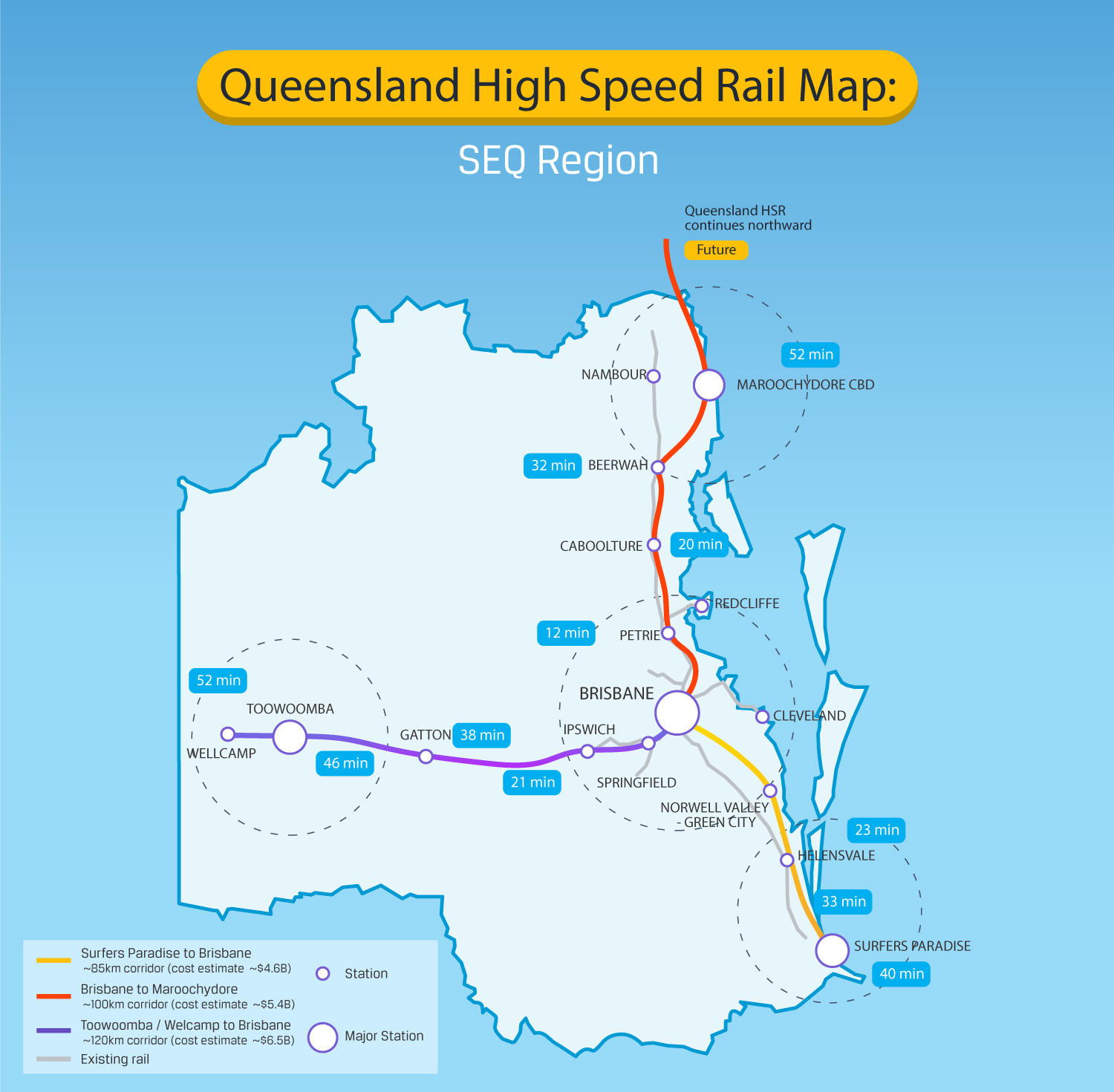
A route which takes advantage of flat open space and existing highway and rail alignments thus reducing the amount of property resumptions is most ideal. In some cases, using existing rail corridors such as the new underground Cross River Rail would also cut costs when it comes to the urban corridor sections of the alignment, however upgrades would no doubt be required.
Along the way, between Brisbane and the Gold Coast and Sunshine Coasts, there would be opportunities to create new ‘green commuter cities’ which would also help South East Queensland’s housing affordability and population growth pains.
The Norwell Valley for example, an area which is currently zoned outside the SEQ Urban Footprint, could possibly be rezoned for a new green commuter city.
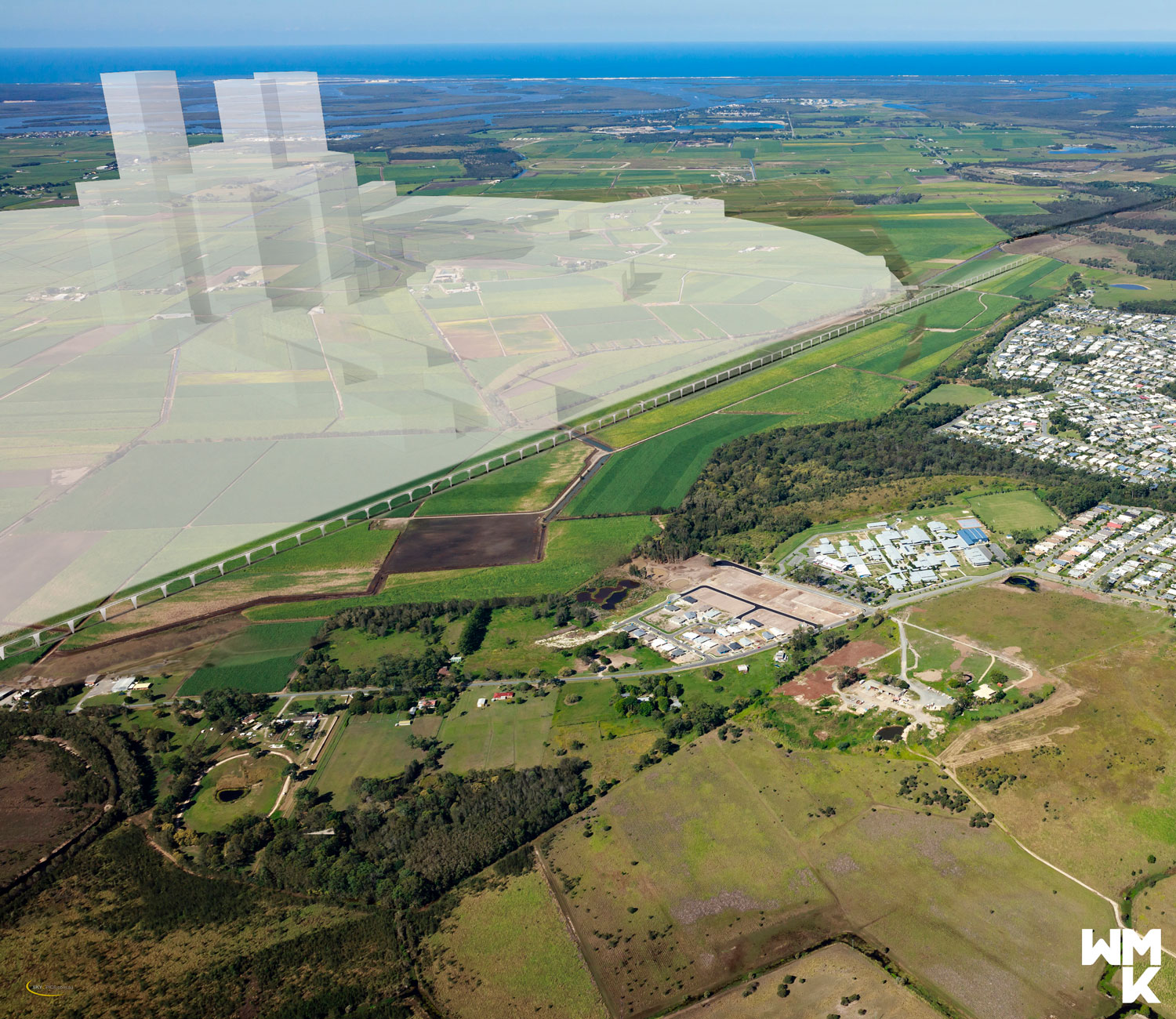
According to an AECOM High Speed Rail study done in 2011 for the Department of Infrastructure and Transport, Roma Street station was shortlisted as the best station for implementing HSR operations if existing facilities are reconfigured. Although this study was done for a national high speed rail system, the same fundamentals would be applied to a regional HSR system due good connectivity with the Citytrain network as well as busway services, as shown in WMK Architecture’s Roma Street station concept image below.
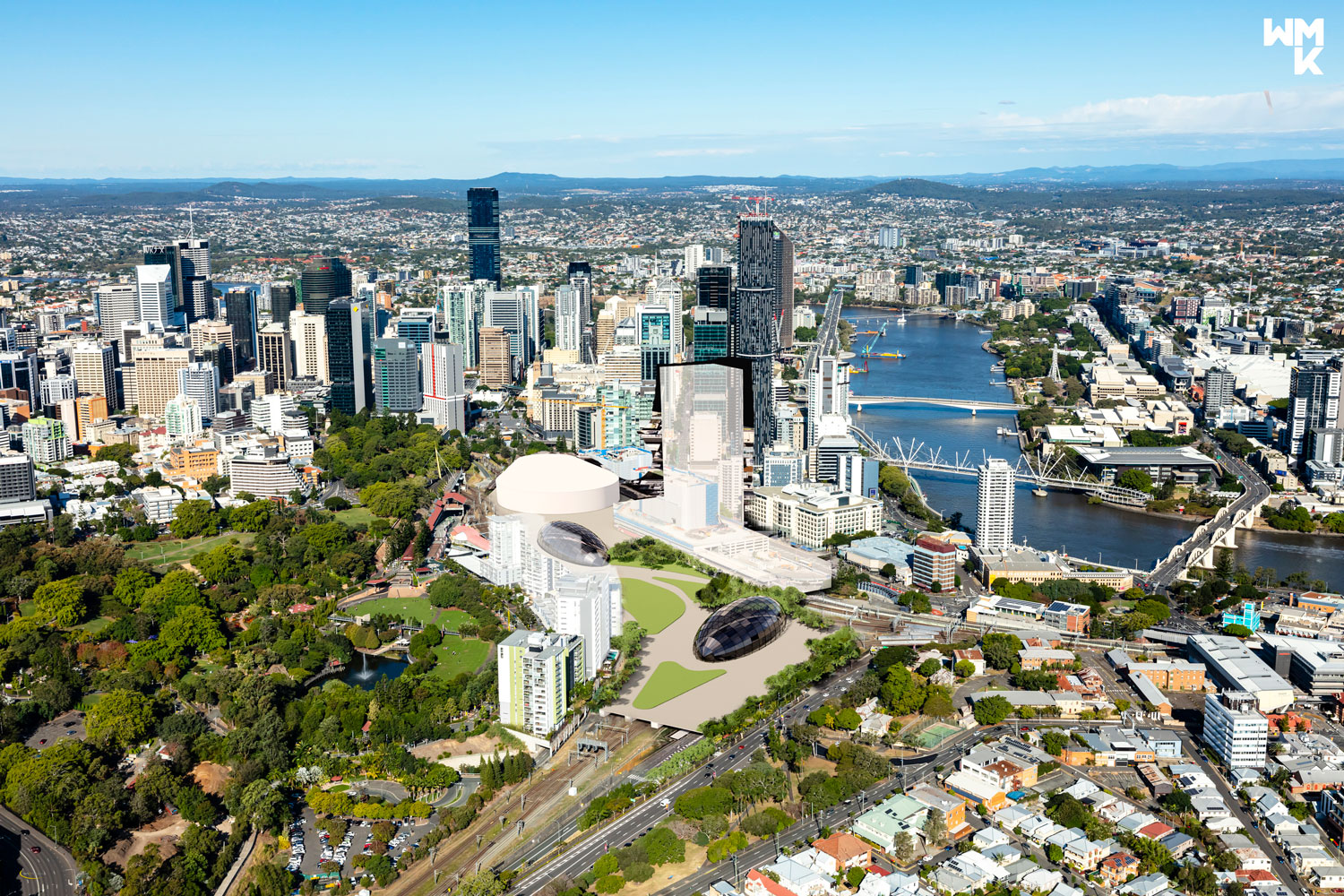
In terms of a hub for the Gold Coast, a centralised location is necessary in order to meet the needs of the majority of commuters. This means that Surfers Paradise or Broadbeach which boast a centralised location would be most ideal, especially if linked with existing G:Link light rail services.
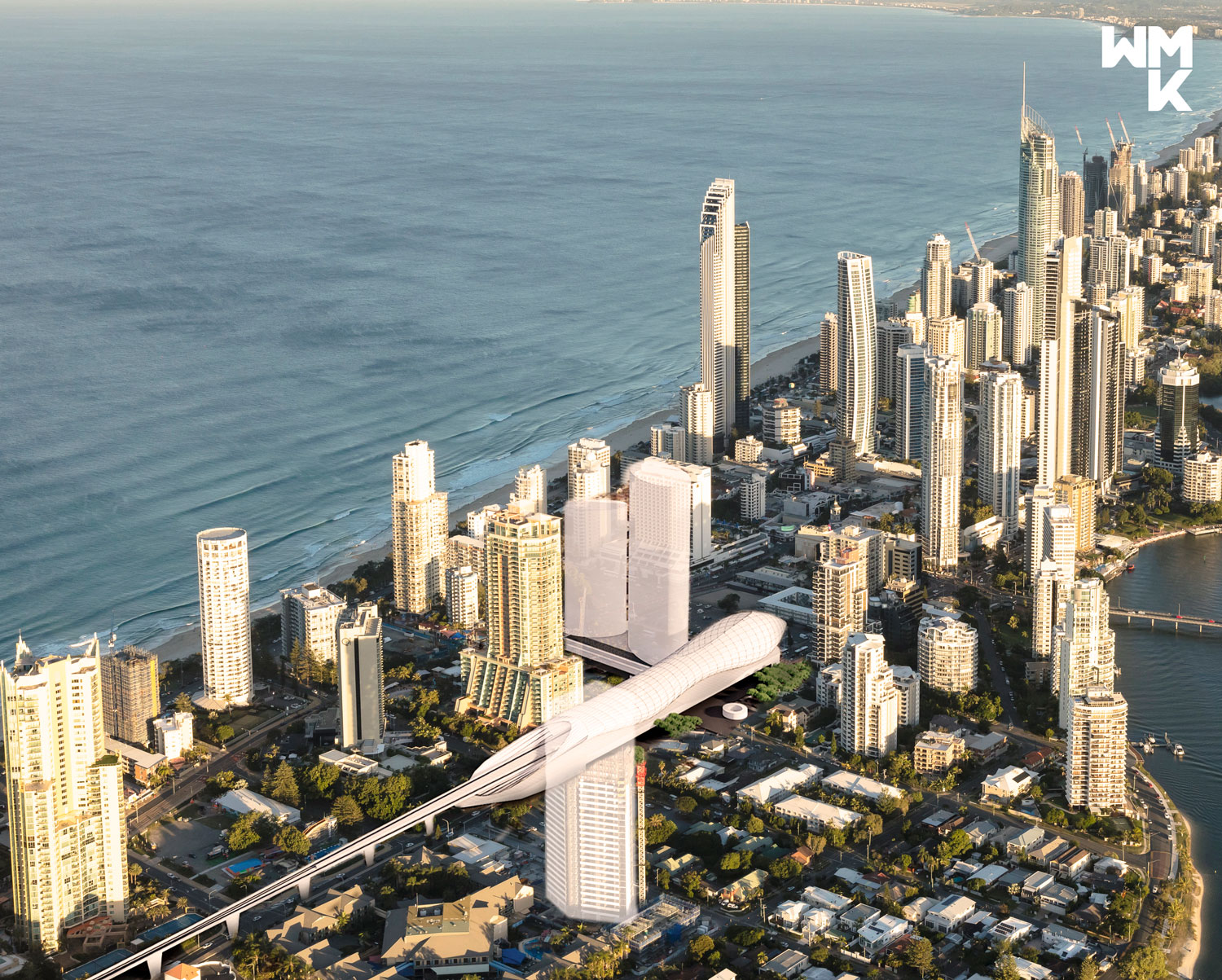
The Sunshine Coast’s new CBD at Maroochydore which is currently under construction already has a transit interchange and corridor worked into the masterplan and would be an ideal candidate for a Sunshine Coast station.
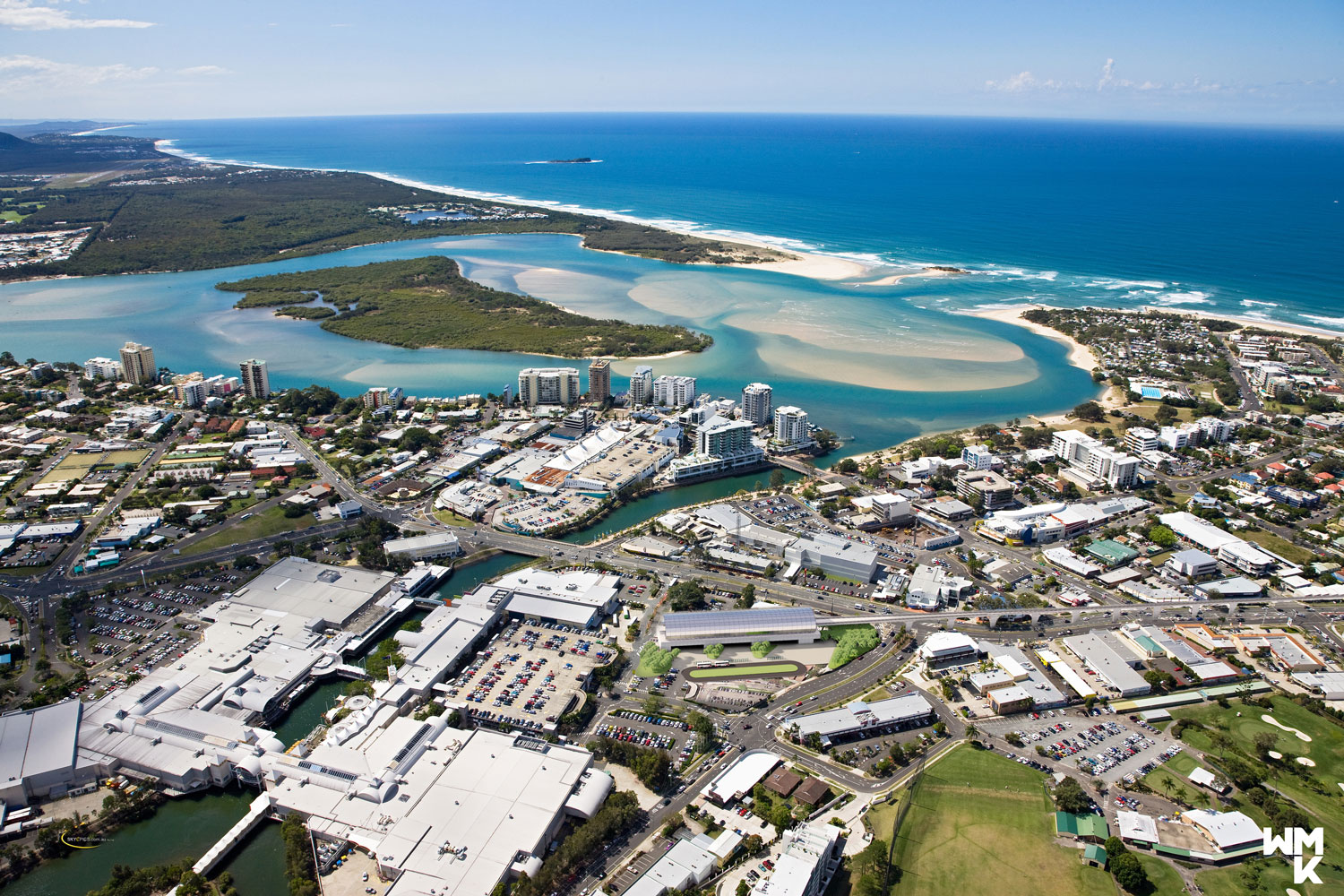
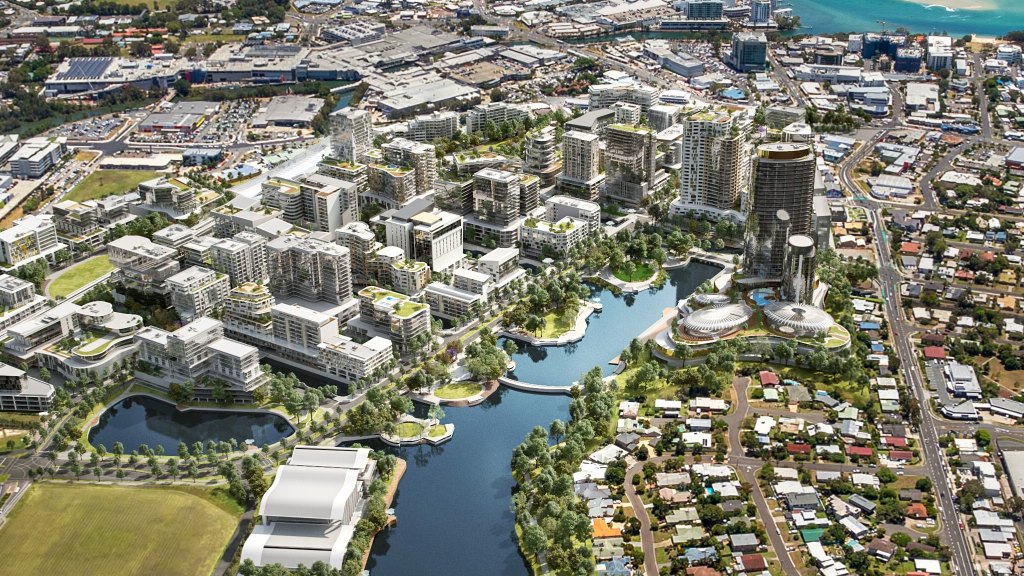
After numerous national studies and business cases on high speed rail in Australia, in July 2019, the federal government established the ‘National Faster Rail Agency’ with the aim of developing rail infrastructure between major cities and key regional centres in order to ‘advance social, economic and population outcomes’.
This recently created federal agency will only focus on regional high speed rail, as opposed to a national east coast system. Queensland can no longer wait for a national high speed rail initiative, we must build for our region today – taking into account the ability to one day mesh with a national Brisbane to Melbourne system.
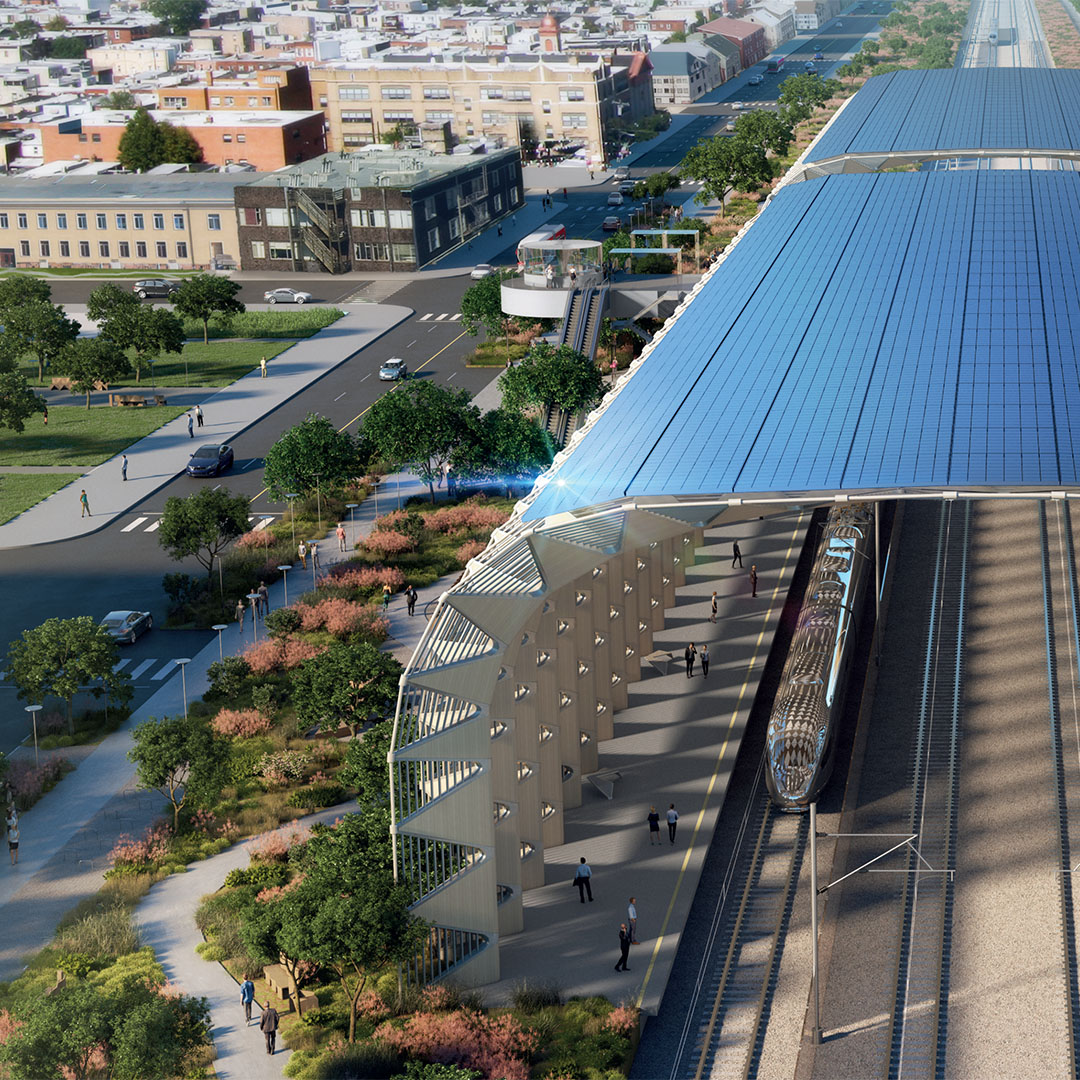
At the moment there are two regional ‘faster rail’ business cases underway for South East Queensland. The first is a $10 million study into a proposed link between the Sunshine Coast (Maroochydore) and Brisbane City.
The second is a $22 million study into a fast rail link between Brisbane and the Gold Coast. The Australian Government is contributing $8 million and the Queensland Government $14 million.
The aim of these business cases, which are to be delivered by the end of 2022, is to investigate options to provide faster passenger rail services within the region. Part one of the study is to develop a detailed business case and part two will identify and develop a corridor strategy.
Getting the exact cost of a hypothetical project without knowing the precise route or scale can be almost impossible, however if we use the metrics from a key AECOM high speed rail study done in 2011, which identified potential costs of a Brisbane to Newcastle HSR segment (via the Gold Coast) we can get a rough idea of the cost.
The Sunshine Coast to Brisbane line would be around 100km in length, with Brisbane to the Gold Coast being around 85kms and Brisbane to Toowoomba being 120km. This roughly equates to 305kms of high speed rail track.
The highest of three projected costs outlined in the AECOM high speed rail study of 2011 for a Brisbane to Newcastle route (via Gold Coast) was estimated at $31.7 billion for 706km of 200-350kph track. This would equate to around $44.9 million per kilometre of high speed rail track if applied to South East Queensland’s corridor.
This works out to be around $13.7 billion in 2011 dollars. If we bring this figure into todays dollars and adjust for ten years of 1.9% annual inflation, this figure would sit roughly around $16.54 billion for 305 kilometres of high speed rail track.
Whilst it may seem high, to put this into perspective, the Sydney Metro, a mass transit infrastructure project servicing the Sydney region with a population of 5.3 million is costing $20.8 billion. Melbourne’s proposed suburban rail loop, which services a population of just over 5 million is in its early planning stage and estimated to cost $50-100 billion over the next three decades. South East Queensland’s population will be at 5.8 million in 20 years.
Door-to-door travel times saved
Our region is perfect for high speed or faster rail because the distance between major population centres isn’t that far away but still far enough to sit in traffic for hours if highways are gridlocked.
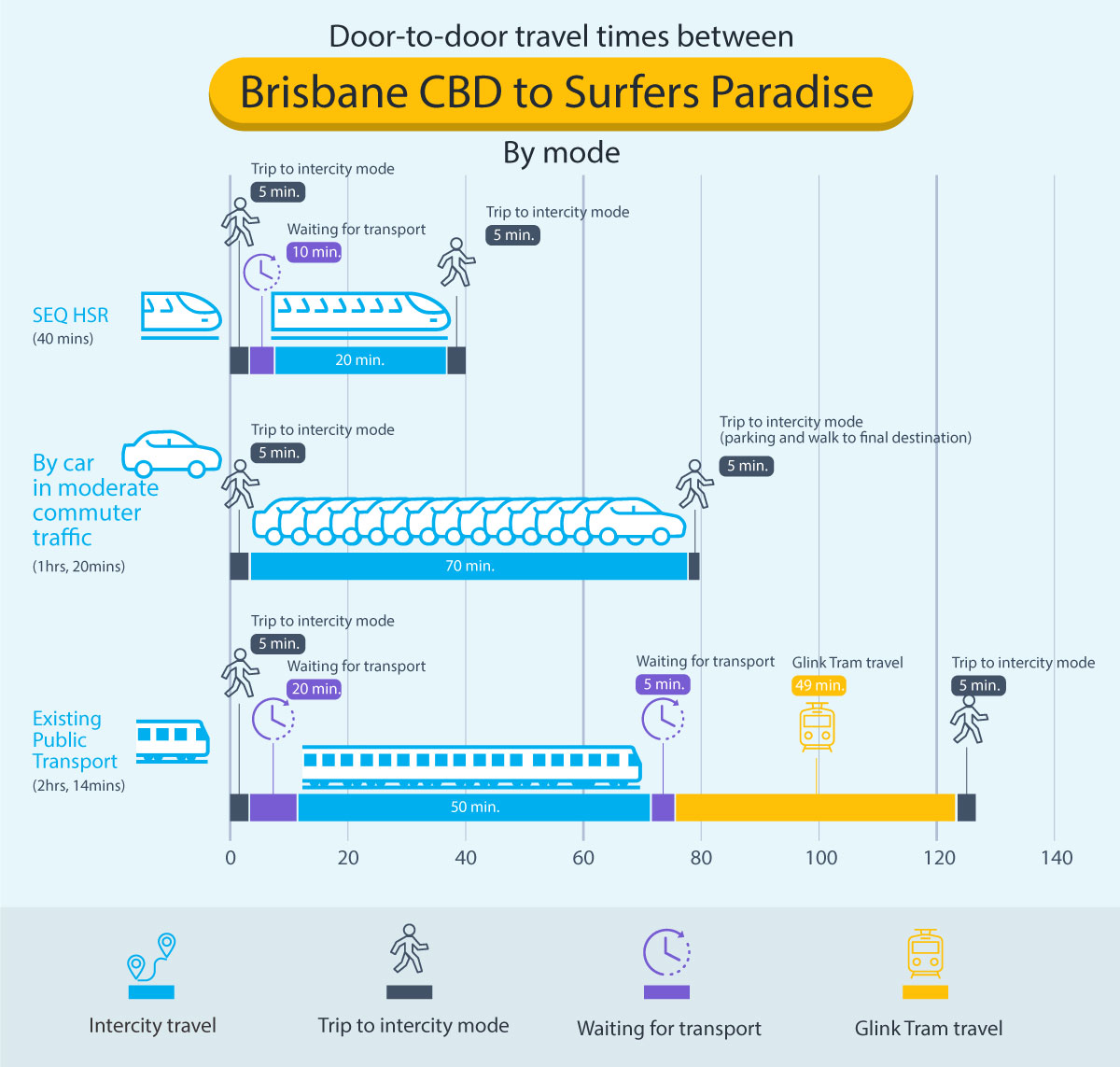
Currently, getting from Brisbane CBD to Surfers Paradise usually takes upwards of two hours using existing public transport, significantly more than driving. We need to change this in order to motivate residents to make the switch. Cutting door-to-door journey times from the CBD to central Gold Coast from one hour and twenty minutes drive to just 40 minutes on a train changes the game dramatically.
The viability of a super fast Shinkansen style 350km high speed rail network might not stack up in the short term. However, will the $1.5 billion Coomera Connector generate a profit? Are the Bruce Highway upgrades currently underway viable financially? Road projects in Queensland tend to be treated differently and given preferential advantage compared to rail infrastructure which traditionally have to prove itself as a viable profit making asset.
The question is why would a fast rail project need to be run like a business and not like a road? Rail is not only more sustainable but easier to scale up to meet future demands. While the first ten or twenty years may not produce a direct profit for the government, there are intangible social benefits, like what roads provide to regions that would drive livability in South East Queensland.
Forget the sporting legacy, Queensland’s Olympic legacy should fair and square be about building fast rail infrastructure to unleash mountains of benefits for residents of Australia’s fastest growing region.
A fast rail network would be the backbone for local industry to not just thrive and innovative but to attract national and international talent to our region.
We cannot rely on congested motorways and the old Citytrain network to move Queenslanders around the region. 5.8 million people commuting by cars will spell a disaster in 20 years time.



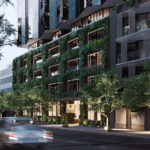

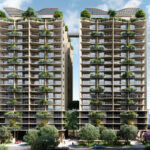
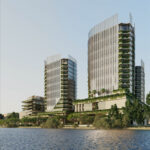

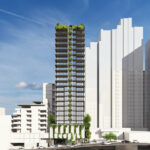

Great article very relevant – and I think will be better for people’s safety , the environment, and our community health and well being .
Fantastic article highlighting the importance of infrastructure in Queensland.
That Norwell Valley visualisation is strange. Assuming the viaduct is the HSR, they’ve put it on the very edge of the development and well away from the highest density. This shows a serious lack of understanding of transit-oriented development principles.
Do you really see any political will to do this? It is an easy political bandage to keep widening the M1 which is abject nonsense. But like Sydney, we will stuff around and it will become urgent but at a price multiples of what it could have cost. People along the train route will be NIMBY, up in arms. And the political hacks will back down to them just like the dams.
This is a pivotal point in our history where something like this is realistically in reach, I just hope the powers at be also realise this.
Very good concept, let’s hope it will be realised and not another study that won’t see the light of the day. If prediction were correct and SEQ will add another 2 million people in the next 20 years, no amount of lanes added to M1 or Bruce or Centenary Highway will solve the congestion. Although I must say that having a hub in the center of Surfers Paradise is a bit odd, considering the sound pollution and to build a track on top of Gold Coast Highway will be challenging and expensive. Helensvale on the other hand makes more sense where it has been linked with G.Link all the way to Broadbeach.
What a dream come true to have a reliable fast high speed rail/metro system like they do in Europe – who wants to spend their life in a car or traffic when u can relax & enjoy the scenery. It’s a no brainer…
Fast rail must be a priority solution for SEQ. Rather than adopting a piece meal approach though we need to look at transport and population growth in an integrated way. Only then will we design solutions that meet all the requirements. A trap is to assume that fast rail will cost more than keep doing what we have been doing. There needs to be an proper business case that underpins the plan. In that business plan valuing the lifestyle and ecosystem must be incorporated. Governments are notoriously poor at finding the right solution because they are often weakly motivated by business case. You must also consider energy source and consumption in the plan.
I agree, this is a great article- hopefully we will see this come to life in SEQ, especially if Brisbane gets the Olympic games.
Japan Rail have set up shop in Sydney and have been showcasing their abilities here in Brisbane- hopefully they are taken seriously as a contender to build a line in South East Queensland.
J.R. are building a high speed rail network in the U.S. -about the same length of line as would take to get from Coolangatta to Maroochydore- , so if they can do it there, they could do it here too. BRING IT ON!
Finally something smart from this government…. it needs to be well under hour between sunshine coast and Gold Coast to be attractive enough to live car behind. Sunny Coast to Brisbane should take no more than 20 min. Forget stops in between, there should be only 4 stops or hubs. Sunshine Coast, Brisbane, Toowoomba and Gold Coast. anything I. between will kill efficiency of the network.. Shoulysd be 350-400kmh.
$1.53 billion is just for Stage 1 of Coomera Connector – the first 16 km out of 45. The total cost of 45km will be about $4.2 billion.
I agree Bris to GC via Fast Rail (40mins) sounds enviable for SEQ Residents.
The reality though is unless there’s 1000km of track it isn’t Capatalistically viable for any Corporation to Tender due to not having any valuable Tech Infrastructure Hubs (ie: Google, IBM).
You just need to see how SANDAG failed due to the funding blowout for San Diego to San Francisco & outer Counties lines, reverting to Merced to San Fran only (Hospitals, Tech hubs).
Qld [Australia] needs FastER rail, as per Bris/GC, Bris/SSC and Bris/Twmba. In fact, it makes big sense! Not “Fast Rail”….a completely different thing and a way harder sell in Australia.
Great opinion piece that is very genuine, and one which is has a credible strategic plan needed for the South East QLD region in the long term. One of which is currently non-existent.
This is the opportunity to do this, and we are nuts to not do it for the Olympics.
My only criticism here is the Gold Coast link. Linking this to Surfer’s Paradise isn’t right – it should instead focus on the existing QR line that needs to extend to the GC Airport (something that’s been on the agenda for a while now). Gold Coast is moving forward with the Light Rail project and is doing a great job at delivering. It will undoutbedly (eventually) extend to GC Airport / Coolangatta. Therefore, a high-speed rail line that extends to the border will capture more passenger intake/offload numbers. It will deliver public transportation where it is needed most. If high speed rail can work in line with the GC light rail project, GC will become a very well connected city for people to access more easily.
What a great idea, Ofc it won’t happen cause they’d rather waste money extending the slow G:link that takes ages to get anywhere and even if they did it what a waste of money building the light rail
the fanciful ideas are about things we do not need and again grade 8 solutions, to imagined issues, by graduate town planners, i.e. just throw it away and buy a new one! how about thinking about why we need this? are we not working from home? why do we need to get to the city 8 minutes quicker? use your alarm clock , who needs more potted plants on concrete structures? its just another set of ideas from the multinational construction companies to continue their pipeline of tax payer funded public infrastructure and labeled and supported by the CFMEU/labor party, as jobs, jobs, jobs, ok yes we need jobs, why not spend the same money better on regional infrastructure? rather than re working the same boring parochial back water city? the world does not care or know where Brisbane is so lets stop building things to impress Europeans or Canadians.
Interesting article. I live on the Sunshine Coast. It is shameful that the 3rd largest city in Qld, 100kms from the capital, has a goat track for a highway (still!) and no heavy rail Inter City train network. Instead we get a single line suburban service to a town in the hinterland.
SC deserves a true Inter City Express linking Maroochydore, Mooloolaba, Kawana and Caloundra. Just do it!
Possibly the main benefit would be an increase in safety.
I would rather see the NCL upgraded between Townsville and Rockhampton first to provide the North with better access to South East Queensland. We should be looking at developing other regions to take the strain off of SEQ and providing fast rail between cities like Townsville and Brisbane is a way to do that, worrying about travel within SEQ is very narrow minded and lacks vision, but there is a reason Queensland is known as a backwards state. It is already demonstrating this with NSW and Victoria boosting links between their state capital and their regional cities like Queensland is hyperfocused on travel around SEQ and leaving the other regions left out as always, no wonder there is always this constant talk of the state being separated. This is a prime example.
Yes Maroochydore really needs a better connection to brisbane.
To Bernice Cox that wants NCL upgrade from Townsville to Rockhampton to Brisbane, I’m guessing you live near Townsville, there is a airport in Townsville that has quite a few flights to Brisbane everyday, SEQ need to deal with the traffic congestion here before thinking about Townsville, you really need to look at how bad the traffic is around Brisbane, specially between Brisbane and the Gold Coast, have you ever driven between theses 2 city’s on the M1, M3 ? I bet not and if you have it was probably years ago! The amount of car and truck accidents is getting higher ever day because there are more people moving to SEQ not Townsville, do your research and think before you write stuff that benefits a small amount of people compared to SEQ poeple who have to use the roads to live!
Look at how many poeple are moving to Townsville compared to SEQ!!
You are narrow minded person for what you typed!
Why not have the airports of the 4 SEQ cities as the terminus point of each direction with Roma Street the centre hub for all 4 lines. And it would almost resemble the Southern Cross.
The route for each line could then easily pass through major hubs both of residential and business sectors ensuring future require coverage is encapsulated in the lines to their respective Airport Hub. But also have express airport to airport, via Roma St, trains so air travellers can easily connect to different airtravel destinations from a wider range if Carriers etc.
This is a great idea lets get going on it.
Fast rail needs solid foundations to support the weight of the trains and to prevent them from derailing. Alluvial soils are loose and unconsolidated, which means that they are not strong enough to support the weight of fast trains. Additionally, alluvial soils are prone to settling and liquefaction, which can also cause derailments.
Here are some of the reasons why fast rail needs solid foundations and cannot be built on alluvial soils:
Weight: Fast trains are very heavy. The weight of the trains can cause the alluvial soils to settle, which can make the track unstable and lead to derailments.
Vibrations: Fast trains produce vibrations that can cause alluvial soils to liquefy. When liquefied, alluvial soils behave like a liquid and can flow, which can make the track unstable and lead to derailments.
Erosion: Alluvial soils are easily eroded by water and wind. This can cause the track to be washed away or undermined, which can lead to derailments.
For these reasons, it is not possible to build a fast rail network on alluvial soils without taking special precautions. These precautions may include:
Reinforcing the alluvial soils with piles or other foundation elements.
Building the track on a raised embankment.
Using a different type of soil that is more stable.
The cost of taking these precautions can be significant, but it is necessary to ensure the safety of passengers and the reliability of the rail network.